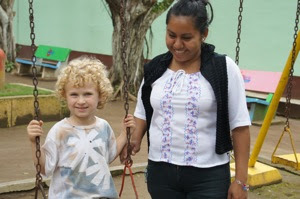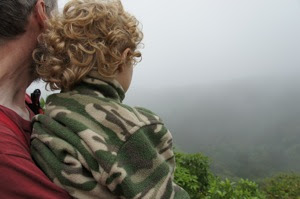

Jeremy is still not happy doing lessons on his own, so I took my second lesson and we went with Jeremy’s teacher off to Jinotepe to check out a playground there. Jami had told me it was much better than the park in La Concha, which is just five minutes up the hill. So we waited 10 minutes for a microbus, rode 25 minutes to Jinotepe, walked ten minutes through Jinotepe to the park (which instead of having one pyramid style slide and one set of swings had maybe three sets of swings and a metal slide as well as a pyramid style one). We spent ten minutes at the park, with Jeremy begging for sweets from the stand nearby the entire time. Then I carried Jeremy for fifteen minutes through the Jinotepe market and we took a very slow microbus back. Kind of an exercise in futility all around. I’ve got to figure out better ways to keep him happy: he really misses his friends, especially Libby, Andreas, and Linda!
Yesterday morning, I went to order some maracas from a man in San Juan who makes them. He starts with a jícara fruit, cuts off the tip, makes the inside into juice, then hollows it out and leaves the shell to dry. Then they put in the sound-makers, attach a stick to the end, paint it red and black (Sandinista colors), and cut designs through the paint. He was just amazingly fast at cutting the pattern! He produced this design in the space of about a minute! He lives in a neighborhood called “Chorizo” (the sausage), perhaps because people are so densely packed in.
















































